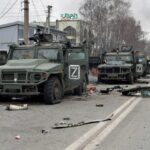
It will only become more difficult — and, in some cases, nearly impossible — to keep up with the costly and deadly effects of climate change without drastic action to reduce greenhouse gas emissions.
That’s one takeaway from the new United Nations climate report released Monday, which details risks to ecosystems and people across the globe in the face of human-caused climate change — and a warning that also rings true for the Great Lakes region and Illinois.
The latest report from the U.N. Intergovernmental Panel on Climate Change covers the daunting conditions to which people have already had to adapt, and warns of struggles ahead: more water scarcity, food insecurity, displacement due to extreme weather events and risks to human and ecosystem health.
“Today’s IPCC report is an atlas of human suffering and a damning indictment of failed climate leadership,” United Nations Secretary-General António Guterres said at a news conference. “With fact upon fact, this report reveals how people and the planet are getting clobbered by climate change.”
Adaptation is increasingly important as some climate effects are likely to continue for decades even if heat-trapping emissions are reduced. But some communities are struggling to keep up, and the paths forward narrow as temperatures rise, according to Monday’s report, written by 270 researchers from 67 countries and approved by 195 governments.
And what works now might not work in 20 years — or sooner.
There’s been a lot of ground covered, but it’s not happening fast enough, said Trent Ford, the state climatologist.
“What this report says in many different ways is that change is not only outpacing our adaptation, but outpacing, in some cases, our adaptive capacity,” Ford said.
On a local scale, for example, climate change looks like the intense rains capable of overwhelming the city’s sewer system and sending sewage into Lake Michigan or sludge into residents’ basements.
“And in order to avoid continued if not accelerated changes in those extreme rainfall events, we have to drop, quickly, greenhouse gas concentrations and emissions overall,” Ford said.
But when it comes to other effects of climate change, such as sea level rise, at a certain point there might not be a way out through urban planning.
“You just have to either avoid — or move,” Ford said.
Although some have predicted the Great Lakes region will become a haven for people who flee damage from wildfires, drought and hurricanes elsewhere, the region’s climate is also transforming — with starker changes projected.
A climate assessment for the Great Lakes region detailed challenges including rising temperatures, flooding caused by a growing number of “unusually large” precipitation events and an increase in extreme weather.
In Illinois, the average daily temperature has increased throughout most of the state in the last century by 1 to 2 degrees, a state-specific climate assessment found. Winter warming has been most pronounced.
Meanwhile, average annual precipitation has increased by 5% to as much as 20% in parts of the state, and there are 40% more days with 2 inches of rain or more.
These shifts are likely to have far-reaching effects on human health, farming practices and cities of paved surfaces — Chicago will have to contend with the urban heat island effect, which leads to pockets of higher temperatures.
Similar to the IPCC report’s finding that the poorest nations are being hit hardest, the Illinois assessment found low-income communities and communities of color are likely to disproportionately face fallout.
“The impacts of climate change, much like the causes of climate change, are not equally borne among the global populace,” Ford said.
Monday’s report follows the first part of the sixth climate assessment, released in August and focused on climate science, which found that humans have caused the climate to change in every region across the globe in unprecedented ways.
Monday’s report made clear the importance of long-term and less reactive planning, Ford said, over hard engineering projects such as sea walls that might act as a Band-Aid.
The report also scaled up discussion of mental health impacts, Ford said, from distress caused by what’s happening to ecosystems to exposure to disasters or even anticipation of the next one.
“When we’re told about how things are changing, we’re experiencing more floods and droughts and things like that, it can cause some serious anxiety,” Ford said.
Limiting the most dire consequences requires limiting warming. The earth has already warmed by 1.1 degrees Celsius since pre-industrial times as people have spewed heat-trapping gases into the atmosphere by burning fossil fuels. Keeping warming within the 1.5 degrees Celsius (2.7 degrees Fahrenheit) threshold — which scientists say is needed to avoid even more calamitous effects — would require a drastic reduction in carbon emissions. Instead, that benchmark could be passed within decades.
Children who were 10 or younger in 2020 could experience a nearly fourfold increase in extreme events by the end of the century if 1.5 degrees Celsius of warming is reached, the IPCC report said, and a fivefold increase with 3 degrees Celsius of warming.
The message seems to get worse with each assessment, said Donald Wuebbles, emeritus professor of atmospheric science at the University of Illinois and a lead author of the state’s climate assessment. But he’s still hopeful that we can meaningfully reduce emissions.
“That hope gets a little less every day because every day that goes by means it’s less likely that we’re going to hit 1.5 degrees as the stopping point,” Wuebbles said.
The takeaway shouldn’t be that we can’t adapt, Ford said.
“This isn’t a problem without a solution,” he said. “A lot of the solutions are there, it’s just a matter of implementing them.”
The next report, to be released later this year, will focus on ways to reduce and stop greenhouse gas emissions.




